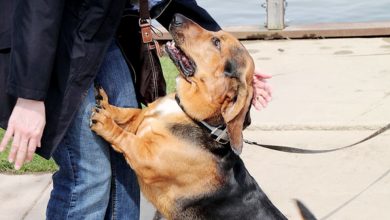Discover the Secret to Silencing Your Dog’s Barking – Once and For All!

1. Introduction
Dogs are an important part of life for many people, but their barking can be a source of annoyance for both pet owners and neighbors alike. In this article, we discuss how to muffle dog barking in order to reduce noise levels and ensure a peaceful living environment. We will look at the reasons why dogs bark, strategies for reducing barking, desensitizing your dog to triggers, tips for training them not to bark, utilizing tools to muffle the sound and professional advice on muffling dog barking.
2. Why Dogs Bark and How to Identify the Source of the Barking
Dogs bark for a variety of reasons: fear, boredom, excitement or even just as a way of communicating with other dogs or humans. It is important to identify why your dog is barking in order to find the best solution for muffling the sound. Common causes of excessive barking include separation anxiety, territorial behavior or even just plain old boredom.
3. Strategies for Reducing Dog Barking
The key to reducing excessive barking is prevention; if you can prevent your dog from engaging in behaviors that trigger their barking then you can reduce the amount they bark overall. Some strategies that can help reduce your dog’s barking include providing them with plenty of exercise and stimulation throughout the day, using positive reinforcement techniques when training them not to bark and making sure they have plenty of toys and activities available when they are left alone.
4. Desensitizing Your Dog to Triggers of Barking
Desensitizing your dog is also an important step in reducing their excessive barking; this involves gradually exposing them to whatever triggers their barking so that they become used to it over time and no longer feel a need to react by barking. This could involve playing recordings of noises such as fireworks or thunderstorms at low volumes and gradually increasing the volume over time until your dog is no longer startled by it or introducing them slowly but surely into situations where they may feel threatened such as meeting other dogs on walks or visiting busy places like parks or shopping malls.
5. Tips for Training Your Dog Not To Bark
Once you have identified what triggers your dog’s excessive barks and taken steps towards desensitizing them it’s time to start training them not to bark unnecessarily; this can be done through positive reinforcement techniques such as rewarding good behavior with treats or praise when they stop barking when asked too as well as teaching them basic commands such as “quiet” which should be used consistently whenever they start up again after being quieted down initially. It may take some time before these techniques take effect but with patience and consistency you should see results eventually!
6. Utilizing Tools To Muffle Dog Barking
In addition to training methods there are also various tools available on the market that can help muffle your dog’s barks; these range from anti-bark collars which deliver a mild electric shock whenever your pup starts up again after being quieted down initially through ultrasonic devices which emit a high-pitched sound whenever they start up again after being quieted down initially through white noise machines which generate soothing background noise that helps block out any external noises that may be causing them distress such as traffic or loud music from nearby homes/businesses etc.. All these tools should be used with caution however – always consult with an expert before using any type of device designed specifically for muffling your pup’s barks!
7. Professional Advice On Muffling Dog Barking
If all else fails then consulting with an expert may be necessary; professionals such as veterinarians and animal behaviorists are trained in understanding canine behavior and can provide invaluable advice on how best to muffle your pup’s barks without causing any harm in the process! They may also recommend specific products designed specifically for this purpose such as citronella collars which emit an unpleasant odor each time your pup starts up again after being quieted down initially – these products should only ever be used under supervision however so make sure you consult with an expert first before investing in one!
8 Conclusion
>
Muffling excessive dog barking requires patience, dedication and consistency but it is possible! By identifying what triggers their barks, desensitizing them slowly over time, utilizing appropriate tools (under supervision) and seeking professional advice if needed you should eventually succeed in helping reduce your pup’s annoying habit!


